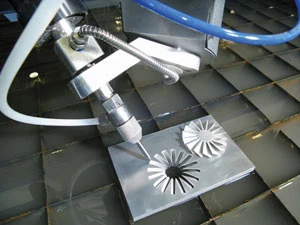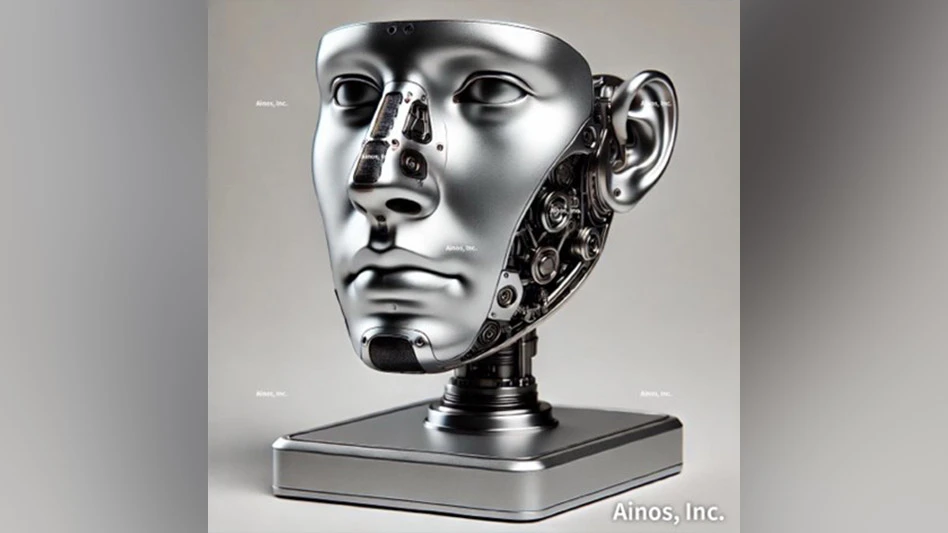
Cutting with water and abrasive in five axes of motion poses some interesting challenges.
Imagine taking an ultra-high-precision, multiple-axis mechanism with everything from electronics, circuit boards, multiple motors and sensors, and giving one person a garden hose to spray all over the mechanism, while simultaneously giving another person buckets of sand to continuously throw over the mechanism while under power. Not quite everyone's idea of a friendly working environment.
One cannot ignoring waterjet cutting is forging its place into every area of manufacturing and engineering.
New materials often demand waterjet cutting. With single and multiple head 5-axis waterjet cutting available on a single machine, the technology is becoming more and more accessible, and the lack of that capability is becoming a competitive disadvantage.
Waterjet is opening doors so fast it is difficult to keep up with the unlimited opportunities. Forgings are being replaced with parts nested into sheet material that are effortlessly cut into the most complex of shapes. Castings are being scanned and flashing trimmed, eliminating multiple tedious steps and labor. Near-net-shape-cutting of everything from complex blades, to medical components, to accurate cutting of composites, laminates of high nickel alloys, glass and phenolics, plastics, ceramics, armor plating of most every make and composition are easy. And this is no longer limited to flat, plane cutting. If you can imagine it, waterjet can probably be used to cut it.
The principles of waterjet cutting are fairly simple. In a nutshell, water at pressures of 60,000psi or higher is channeled to a cutting head through sheathed, 1/4" diameter auto-frataged stainless steel tubing. Abrasive is then fed to the cutting head where the water pressure, as it transitions from potential energy to kinetic energy, accelerates the abrasive grains to over 2,200mph in a nozzle that is 3" long.
The applications for 5-axis waterjet cutting are endless, and the physics behind the process are impressive.
But what are the challenges driving the design engineers who eat, sleep and drink 5-axis waterjet cutting? Here is a look at how WARDJet engineers have addressed these challenges with the Psy-Winder 5-axis waterjet cutting system.
THE DESIGN
WARDJet's Psy-Winder is a nutating/ precession mechanism where the angle to the material is defined by one axis, and the clock angle to the profile is another. The programming for this design is very simple, and the G-code to describe a beveled circle can be done in two lines. Post-processors are available for both 2D and 3D CAM software. Due to the nature of the Psy- Winder mechanism it is considered a fixed mechanical tool tip cutter so that the motion of the additional rotary axis does not affect the spatial position the cutting point.
Goals set for the Psy-Winder 5-axis cutting head: Ensure the Psy-Winder • is retrofitable to all waterjet systems produced by the company.
- Increased accuracy achieved by using harmonic drive rotary actuators with a hollow bore down the center, and a positioning accuracy of 40 arc-seconds (0.01°). Further accuracy can be achieved though laser tracking measurement and compensation.
- Controller servo cycle/update time of 0.00045 seconds meaning the location of the cutting head is checked more than 2,200 times per second.
- Use of both hardware and software limit and home switches
- Capacity of 12" to 24" vertical travel (Z axis) and, upon request, the flexibility to provide any Z travel specified
- Cutting angle from 0° (vertical) to 90° (horizontal)
- Combination height and crash sensor enabling consistent and accurate nozzle/plate spacing regardless of the behavior of the material being cut.
- Fixed mechanical tool tip
- Ability to flood the tip of the nozzle with water, even if 10" above the water level in the tank, reducing sound and typical variations in cutting quality once air enters the stream.
THE ACCURACY
In years past, when multi-dimensional waterjet cutting was new, the understanding was that there would be a sacrifice in tolerances. This is no longer the case. With advances in engineering of the nozzles, the width of the waterjet stream is now predictable to 0.0005", allowing manufacturers to support demands for precision 5-axis parts.
Key to creating an accurate 5-axis mechanism is the ability to measure the results. WARDJet employs a 3D spatial laser tracker to measure the actual mechanisms and to correct for any real world inaccuracies that crop up in the manufacturing processes or from material properties. Standard laser interferometers are incapable of measuring all of the parts once they are assembled and operating in space.
Once a final mechanism is measured, the data can be used to electronically compensate, on the fly, for any repeatable errors that occu.
HIGH PRESSURE WATER
Imagine your finger is the nozzle in a cutting head. Now wave it around and notice how flexible your wrist, elbow and shoulder are, not to mention the muscles as they twist and flex. So, how do you get high-pressure water bolted to a fixed position on the face of the Z carriage to the fixed position of the cutting head mounted on the other end of an ‘arm' that twists, spirals and rotates? Any additional forces generated in flexing the high-pressure tubing will typically cause variations in positional and repeatable tolerances. Coiling the high-pressure tubing to reduce these forces normally shows unacceptable results in laser tracking.
WARDJet was able to eliminate varying torsion, sheer and moment loads on the cutting head by directing the high-pressure tubing through the center of rotary actuators. The combination of swivels, and routing the 1/4" high pressure tubing means no coiling is necessary. There is no wind up of the high-pressure tubing often associated with 5-axis waterjet cutting since the lengths of the tubing are short.
Additionally, all high-pressure tubing eventually fatigues and fails, releasing high-pressure water from hairline fractures. It is important to design a mechanism that fails in a safe manner, and is easily repaired.
THE ABRASIVE
The abrasive, which is typically garnet ranging from 150 mesh to 50 mesh, is fed into the waterjet stream 3" to 4" above the tip of the nozzle. What has been designed is a revolutionary way to direct the abrasive through the middle of the actuator without any wind up of the 3/8" abrasive resistant hose. This also reduces the length of the path the abrasive travels from the mini-hopper to the cutting head. A swivel system allows the abrasive to be passed through the center of the motor, collected and directed back into a flexible hose. The result is seamless delivery of garnet to the cutting head no matter what position the cutting head is in, or the angle of attack. Bulky tubing and awkward mechanisms subject to pinching, clogs and blockages are reduced into a simple straight path from abrasive hopper to cutting head.
CRASH SENSORS
Any 5-axis programming revolves around a common mandate that the part does not change position while cutting. Fixturing for a 5-axis mill is often substantial to ensure the part does not move. In waterjet cutting, one has to presume materials will move through the redistribution of stresses as material is cut.
A spring-assisted, self-locating crash sensor passes a low voltage signal through the foot when an interruption detects a crash. The height sensor is pneumatically-controlled, and can take periodically samples of the location of the material or continuously ride on the material. The analog feedback allows adjustments to be registered and responded to.
What is most impressive is that the height and crash sensor can be deployed to work while the head is cutting at angles approaching 50° off the vertical. This capability, as well as being able to integrate this information and respond in a 5-axis program, is all part of the advanced technology WARDJet has developed.
COMBINING PROCESSES
What if you need additional processes such as drilling, marking, tapping, reaming, liquid dispensing, barcode reading of parts, laser alignment, automatic loading and unloading of parts, plus 100% remote control and monitoring from a PDA in your pocket, while on a business trip in Europe? Well, it is already being done.
Waterjet cutting is still in its infancy, not because people are cutting simple shapes out of flat material, but because doors are opening with phenomenal technology, allowing anyone who thinks outside the box, to leap toward the future.
WARDJet Inc
Tallmadge, OH
wardjet.com

Explore the October 2009 Issue
Check out more from this issue and find your next story to read.
Latest from Today's Medical Developments
- November USMTO grow from October
- Platinum Tooling’s custom and special tooling
- Top 5 global robotics trends 2025
- Accumold’s micro molding innovations
- Methods Machine Tools, Multiaxis, announce AI solution investment
- MGS to showcase global expansion and healthcare CDMO expertise
- Medtronic: 5 healthcare tech trends for 2025
- Norman Noble launches enhanced laser welding capabilities; expands micromachining in Florida





